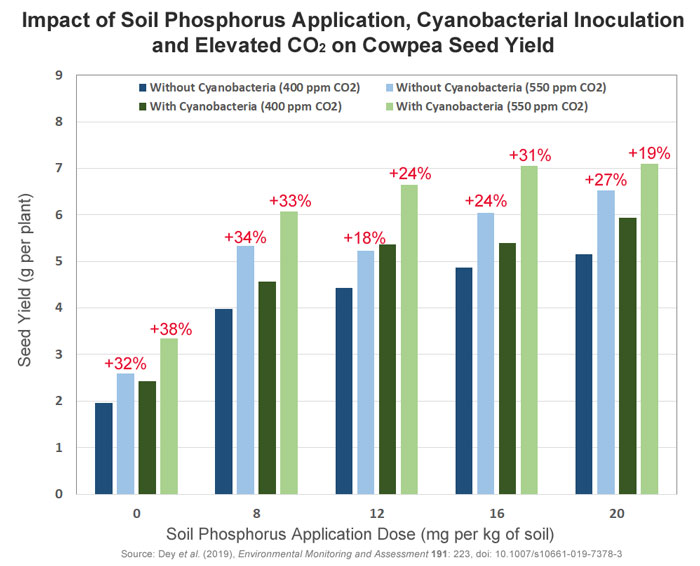| Tweet | Follow @co2science |
Paper Reviewed
Dey, S.K., Chakrabarti, B., Purakayastha, T.J., Prasanna, R., Mittal, R., Singh, S.D. and Pathak, H. 2019. Interplay of phosphorus doses, cyanobacterial inoculation, and elevated carbon dioxide on yield and phosphorus dynamics in cowpea. Environmental Monitoring and Assessment 191: 223, doi: 10.1007/s10661-019-7378-3.
Introducing their work, Dey et al. (2019) say that cowpea (Vigna unguiculata) represents "an important leguminous crop, grown mainly in the arid and semi-arid cropping systems of mostly developing countries," where it is "useful for its contributions to soil nitrogen pools as a result of symbiotic nitrogen fixation ... leading to improved soil fertility." And although much has been learned about factors influencing the growth and yield of this plant, the authors note that much remains to be learned. Thus, it was their intent to investigate the impact of elevated CO2, soil phosphorus content and cyanobacterial inoculation (growth-promoting bacteria that help enhance plant photosynthesis) on this legume of growing global importance.
To accomplish their objective, Dey et al. grew cowpea (cv. Pusa Sukomal) plants in pots at a free-air carbon dioxide enrichment (FACE) facility at the ICAR-Indian Agricultural Research Institute in New Delhi, India, across the kharif growing season (June-October) in 2014. The experimental design included two CO2 levels (400 or 550 ppm), five phosphorus levels (0, 8, 12, 16 or 20 mg phosphorus applied per kg of soil) and two cyanobacteria treatments (with or without inoculation).
Focusing on the most important growth measure, that of seed yield, Dey et al. report that "elevated CO2 level significantly increased seed yield and phosphorus uptake in cowpea, which was further enhanced with increasing doses of phosphorus and cyanobacterial inoculation." As seen in the accompanying figure below, on average, the 150 ppm increase in atmospheric CO2 boosted seed yields across the five phosphorus treatment levels by 25.9% when cyanobacteria inoculation was not applied and by 27.4% when it was applied.
Dey et al. also report that elevated CO2, phosphorus application and cyabobacterial inoculation all led "to increased microbial activity, which in turn, increased the availability of phosphorus in [the soil]." And that increased availability of phosphorus in the soil is what "led to [the] higher seed yield as well as higher phosphorus uptake by the crop." Consequently, as the air's CO2 content rising in the future, farmers will realize significant yield increases in cowpea, which will only be magnified through additional management of soil phosphorus and cyanobacteria application.

Figure 1. Impact of soil phosphorus application (0, 8, 12, 16 or 20 mg kg-1 soil), cyanobacterial inoculation (with or without inoculation) and elevated CO2 (400 or 550 ppm) on cowpea seed yield. The percentages shown in red text represent the seed yield enhancement at a given soil phosphorus application and cyanobacteria treatment that is due to the 150 ppm increase in atmospheric CO2. Data source: Table 1 of Dey et al. (2019).




